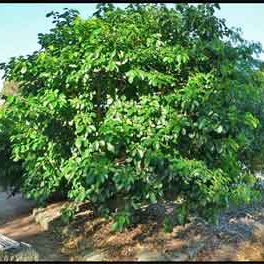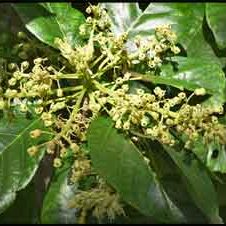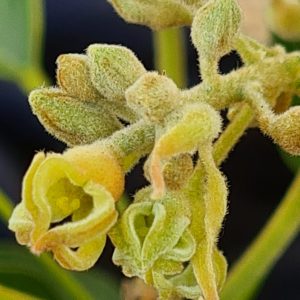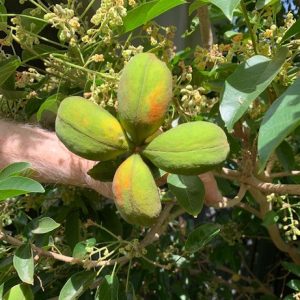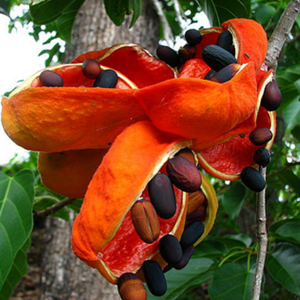Sterculia quadrifida
Peanut tree, faloak
Origin
It is native to northern Australia and one of our indigenous bush foods. It has since become pantropical.
Climate
The tree prefers sub-tropical or Mediterranean conditions. Plant anatomy is consistent with it being a xerophyte that can withstand dry periods, it’s not frost tolerant, grows best in full sun, and is briefly deciduous in sub-tropical climates.
Plant Description
It is a very attractive fast-growing soft-wooded tree, 10-12m high, with a dense crown. The glossy simple elliptical-ovate leaves with an entire margin are caducous and spirally clustered towards the ends of branches. It can produce a gummy exudate when injured.
Relatives
It belongs in one of nine sub-families (the Sterculioideae) in the large Malvaceae family with >4000 species. Currently there are 180 accepted species in the genus. Some other family members producing edible fruit include cacao, durian, South American sapote, baobab, phalsa, kola nut and saba nut.
Soils
It grows well in many infertile sands and rocky soils, but is best in well-draining mildly acid sandy loams. Plant nutrition, particularly in less fertile conditions, is assisted by mycorrhizal associations. In the wild it is often found bordering rivers, but rather than indicating a preference for moist soils it is more a function of seed dispersal by water.
Propagation
Seeds are most commonly used, best selected when black. They are relatively recalcitrant, but will germinate quickly if sown fresh following scarification and soaking in water for 12 hrs. Mature stem cuttings (15-25mm dia) can also be used, however early bud development or stem growth can draw on tissue reserves before new roots become functional, and success at 10 weeks is of order 15-25%.
Cultivars
All plants are seedlings with highly variable properties, and there are no recognised cultivars.
Flowering and Pollination
The numerous axillary inflorescences are panicles, usually in sub-terminal branchlets that are frequently de-foliated. The small apetalous pubescent flowers have a connate perianth and 3-5 reflexed green-yellow sepals that sometimes form before new season leaf growth has commenced. Flowers are structurally andromonoecious but functionally monoecious as morphologically normal pollen in the hermaphrodite flowers is sterile; it germinates with usual pollen tube growth but is usually arrested before zygote formation while still serving to attract pollinators. All flowers have a central androgynophore. In male flowers there are 8-10 anthers on a globose head with each having 2 thecae on very short filaments; there is no ovary. In female flowers the gynoecium has 5 apocarpic multi-locular carpels, each with several ovules (2-12), and anthers at the base. The species exhibits considerable genetic heterogeneity. There is usually a preponderance of male flowers but this ratio varies greatly between trees and can also vary in different seasons and within trees, some trees are male only. Small insects are thought to be the main pollinators; wind is probably not involved. Fruit set with self-pollination is very low but can be improved with cross pollination, either naturally or by hand; in native stands it is usually no more than a few percent and many flowers have stigmas devoid of any pollen. The peanut tree is facultatively xenogamous and probably also apomictic.
Cultivation
As a bush food occurring predominantly in wild stands only, little agronomic research has been done on its fertiliser needs. Given it grows naturally in relatively infertile conditions, it seems fertiliser application could be minimal. Generally it would be wise to water frequently when young, but with maturity it will be more tolerant of dry conditions.
Wind Tolerance
Despite the soft wood, barring cyclonic conditions this is not a problem.
Pruning
Pruning when mature should be an annual exercise to control size given it grows strongly in the Perth region.
The Fruit
Fruit develop as 1-5 apocarpic dry dehiscent leathery-woody globose-cylindrical follicles, 4-8cm long. These turn an eyecatching orange-red as they ripen and open, revealing a variable number of edible hazelnut-sized black coated seeds with creamy white kernels.
Fruit Production and Harvesting
Harvest is normally in late Spring and Summer. Pods are best picked when fully coloured but before they dehisce and will then require dispersed seeds to be gathered up from the ground.
Fruit Uses
All plants devote considerable metabolic energy to produce a variety of defense chemicals that can deter inappropriate predation. Peanut tree seeds contain cyclopropenoid fatty acids (as with many species in the Malvaceae) and these should be degraded by roasting before eating. This also enhances flavour and facilitates seed coat removal.
Pests and Diseases
Generally not a problem, although leaf-eating insects have been reported.
Comments
This species could be chosen solely for its aesthetic value, with dense lustrous green foliage and eye-catching red pods when ripe. In the Mediterranean climate of south west WA it can also produce pods for a number of months of the year. Self-fertility and yield of seedlings is unknown with Nursery purchase but would be helped by grafting or having more than one tree.
